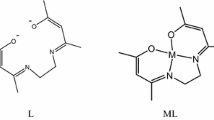Summary
An aqueous solution of Na-salicylate(I) gives an orange-red colour with U(VI) at pH ∼7. Both U(VI) and salicylate can be detected by this test (the limits of detection are 45μg and 25μg resp. in 0.05 ml). A red-orange precipitate is formed whenI is treated with U(VI) in presence ofα, α′-dipyridyl at pH ∼7. Thus, 200μg U(VI) (in 0.5 ml) and 6μg salicylate (in 0.05 ml) can be detected. In the test for U, Fe(III), Ru(III), Cr(III), Ce(IV), Cu(II), [Fe(CN)6]4−, [Fe(CN)6]3−, F−, C2O4 2−, citrate, and tartrate interfere. The latter three anions also interfere in the tests for salicylate. Formate, acetate, succinate, benzoate, and acetylsalicylate do not interfere. Allylamine(II) gives a deep green precipitate with Co(II); however, if salicylate is added to Co(II) and the mixture is treated withII, a bluish-violet precipitate is produced. This forms the basis of salicylate detection (1 mg/0.25 ml). Oxalate, citrate, tartrate, and sulfosalicylate interfere. The nature of products formed in these tests has been discussed.
Zusammenfassung
Eine wäßrige Na-Salicylatlösung (I) gibt mit U(VI) bei pH 7 eine orangerote Farbe. Sowohl U(VI) wie I können damit nachgewiesen werden (Erf. Grenze 45 bzw. 25μg in 0,05 ml). I gibt mit U(VI) in Gegenwart von α,α-Dipyridyl bei pH 7 einen rot-orangen Niederschlag. So können 200μg U(VI)/0,5 ml bzw. 6μg Salicylat/0,05 ml nachgewiesen werden. Der U-Nachweis wird von Fe(III), Ru(III), Cr(III), Ce(IV), Cu(II), [Fe(CN6]4−, [Fe(CN)6]3−, F−, C2O4 2−, Citrat und Tartrat gestört. Die 3 letztgenannten Anionen stören auch den Nachweis von I. Formiat, Acetat, Succinat, Benzoat und Acetylsalicylat stören nicht. Allylamin(II) gibt einen tief grünen Niederschlag mit Co(II); wird aber I dem Co(II) zugesetzt und das Gemisch mit II versetzt, so wird ein blauvioletter Niederschlag gebildet. Auf dieser Grundlage kann I nachgewiesen werden (1 mg/0,25 ml). Oxalat, Citrat, Tartrat und Sulfosalicylat stören. Die Zusammensetzung der Reaktionsprodukte wurde erörtert.
Similar content being viewed by others
References
A. de Sousa, Mikrochem.40, 319 (1953).
G. S. Johar, Labdev J. Sci. Tech., Kanpur, India8-A, 151 (1970).
F. Feigl and R. Stern, Z. analyt. Chem.60, 39 (1921).
F. Feigl, Spot Tests in Inorganic Analysis, 5th Ed., Amsterdam: Eisevier. 1958. p. 208.
C. R. Rao, Talanta9, 81 (1962).
V. I. Paramonova, N. B. Platunova, and V. S. Dubrovin, Radiokhimiya6, 505 (1964).
V. I. Paramonova and N. B. Platunova, Radiokhimiya7, 554 (1965).
F. R. Haba and C. R. Wilson, Talanta11, 21 (1964).
J. Browaeys, Ann. inst. Pasteur72, 149 (1946).
L. K. Yanowski and W. A. Hynes, Mikrochem.29, 235 (1941).
J. Kobal, Jr., Bol. Dept. Quim. Escola Politech. No. 15, 25 (1960).
A. Müller, Chem.-Ztg.43, 739 (1919).
G. Courtois, Bull. soc. chim. France33, 1761 (1923).
P. N. Das-Gupta, J. Indian Chem. Soc.6, 763 (1929).
L. M. Manojlovic, Bull. inst. nucl. sci. “Boris Kidrich” (Beigrade)8, 105 (1958).
N. K. Dutt and N. Goswami, Z. anorg. Chem.298, 265 (1959).
O. E. Zvyagintsev and B. N. Sudarikov, Zhur. Neorg. Khim.2, 128 (1957).
V. Amirthalingam and V. M. Padmanabhan, Analyt. Chemistry31, 622 (1959).
Gh. Baiulescu and C. I. Ciurea, Z. analyt. Chem.166, 5 (1959).
D. Negoiu and C. Vasilescu, Acad. Rep. Populare Romine, Studii cercetari chim.9, 641 (1961).
D. Negoiu, C. Isvoranu, A. Kriza, M. Negoiu, and I. Teodorescu, Analele Univ. Bucuresti, Ser. Stiint Nat.13, 81 (1964).
K. V. Narasimhan, Indian J. Phys.34, 329 (1960).
R. Kh. Dzhiyanbaeva and Sh. T. Talipov, Uzbek Khim. Zhur. No. 4, 17 (1961).
M. S. Barvinok, B. Yu, and L. A. Obozova, Zh. Neorg. Khim.16, 3046 (1971).
Kh. R. Rakhimov, L. P. Nyrkova, and K. I. Inoyatova, Nauchn. Tr. Tashkentsk Gos. Univ. No. 257, 94 (1964).
Author information
Authors and Affiliations
Rights and permissions
About this article
Cite this article
Johar, G.S. Reactions of salicylate with uranium(VI) and cobalt(II)-allylamine complex. Micro detection of uranium (VI) and salicylate. Mikrochim Acta 62, 743–750 (1974). https://doi.org/10.1007/BF01218214
Received:
Published:
Issue Date:
DOI: https://doi.org/10.1007/BF01218214




